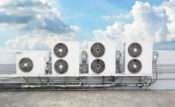 This might be the biggest New Years resolution ever as 197 countries around the world have resolved to scale back the use of hydrofluorocarbons (HFCs). The Kigali Amendment to the Montreal Protocol, a game-changing climate treaty, entered into force as the calendar turned to 2019 and with it, the global HFC phasedown begins on some of the most potent greenhouse gases on Earth.
This might be the biggest New Years resolution ever as 197 countries around the world have resolved to scale back the use of hydrofluorocarbons (HFCs). The Kigali Amendment to the Montreal Protocol, a game-changing climate treaty, entered into force as the calendar turned to 2019 and with it, the global HFC phasedown begins on some of the most potent greenhouse gases on Earth.
The three nations making up North America – Canada, the U.S. and Mexico – are each at different stages in reducing their HFC consumption as 2019 begins.
Canada, having ratified the Kigali Amendment to the Montreal Protocol in 2017, started cutting HFC consumption as of January 1 by 10% and will move to 85% by 2036.
The Canadian plan also puts caps on the GWP of gases that can be used in specific applications. Starting on January 1, 2020, stand-alone commercial refrigeration systems will be limited to 1,400 and 1,500 GWPS for medium- and low-temperature units, respectively, while centralized refrigeration systems and condensing units will be held to a 2,200 GWP refrigerant.
Much of the Canadian regulation focuses on imports since HFCs are usually imported into Canada in bulk for use in the manufacturing, servicing and maintenance of refrigeration and air-conditioning equipment, and in the manufacturing of foam-blowing products.
Mexico voted to accept the Kigali Amendment in September 2018. As a developing country, it will freeze average production/consumption in 2024 at the baseline, which is the average production/consumption of HFCs in 2020, 2021 and 2022.
67 countries have ratified the Kigali Amendment, including the European Union, Japan, Canada, and Australia, as well many developing nations, and the United Nations said it expects more to join in the coming weeks. Notably absent are China and the U.S., the two biggest manufacturers and users of HFCs.
While China is expected to sign on, it doesn’t seem like the U.S. is in any rush to do the same despite widespread industry support for ratification. Just last year, 13 Republican senators asked the White House to send it to the Senate for ratification. The refrigerant industry supports ratification and even published a white paper showing it could result in an additional 33,000 U.S. manufacturing jobs and $12.5 billion in additional economic output to both replace HFCs and destroy the climate-warming chemicals. The industry has also suggested that China could get a leg up on the U.S. if it ratifies the treaty before the U.S. and begins manufacturing and distributing HFC-free refrigerators and air conditioners to the world.
Even if the amendment doesn’t make it to the US Senate for ratification, the U.S. still has some pathways forward to not fall totally behind. Individual states have begun to lead the way with California at the front of the pack. California has already banned HFCs in new air conditioners and refrigerators and a handful of other states, such as New York, Connecticut and Maryland, have followed suit. As well, 17 Governors from various states have formed the Climate Alliance. Aside from upholding the goals laid out in the now defunct Paris Climate Accord, they have targeted other climate and environmental changes and regulations including HFC refrigerants.
The U.S. may end up with a piecemeal of states that phase down HFCs but if enough states jump on board then manufacturers will be forced to use lower GWP alternative refrigerants.
FIELDBOSS stays current on industry trends to keep you informed on what’s happening in the HVACR world. Read our blog and sign up for our newsletter for all the latest news.
#KigaliAmendmentHFCPhasedown